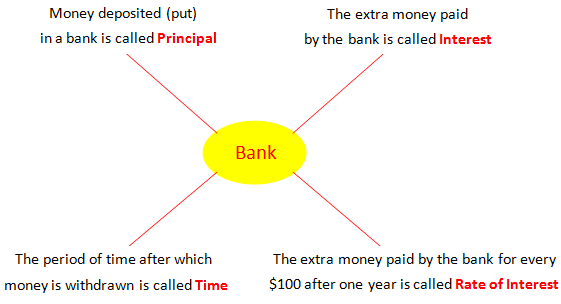Subscribe to our ▶️ YouTube channel 🔴 for the latest videos, updates, and tips.
Introduction to Simple Interest
In simple interest we will learn and identify about the terms like Principal, Time, Rate, Amount, etc.
Suppose Ron has deposited $100 in a bank. Ron goes to the bank to
find out about his deposited money. The manager of the bank informs Ron
that $100 deposited in the bank one year before has now become $110. Ron
enquires how did $100 become $110 after one year?
The manager told that when someone deposits money in a bank, we pay some extra money on the deposited amount.
For example, suppose the bank has given a loan of $6000 to Jack to purchase a tractor. After three years Jack returns back the loan along with 10% interest charged by the bank.
Here, the money borrowed (loan is the principal and the extra money to be paid is called the interest.
The interest is only a fair payment for using another person’s money.
PRINCIPAL (P):
The money you deposit or put in the bank is called the PRINCIPAL.
INTEREST (I):
The extra money you get from the bank after depositing is called the INTEREST.
AMOUNT (A):
The total money means the PRINCIPAL and INTEREST you get after a fix time is called the AMOUNT.
Notes:
P is the money deposited or borrowed called the PRINCIPAL.
T is the TIME or number of years for which the money is deposited or borrowed.
The interest is calculated at a RATE per cent decided by the bank every year. This is R % p.a. (per annum or per year)
PRINCIPAL (P) + INTEREST (I) = AMOUNT (A)
OR
P + I = A
There are two types of interests.
1. Simple Interest (S.I.).
2. Compound Interest (C.I.).
The Simple Interest (SI) remains the same every year.
Word Problems on Simple Interest.
In Simple Interest when the Time is given in Months and Days.
To find Principal when Time Interest and Rate are given.
To find Rate when Principal Interest and Time are given .
To find Time when Principal Interest and Rate are given.
Worksheet on Factors affecting Interest
5th Grade Numbers Page
5th Grade Math Problems
From Introduction to Simple Interest to HOME PAGE
Didn't find what you were looking for? Or want to know more information about Math Only Math. Use this Google Search to find what you need.



New! Comments
Have your say about what you just read! Leave me a comment in the box below. Ask a Question or Answer a Question.